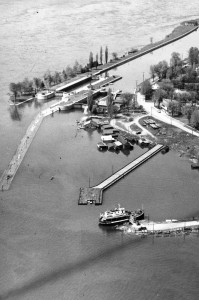Lock 23 is the newest and largest structure of the entire site, constructed in 1905. Its enormous south wall extends upstream well beyond the end of the lock for almost a kilometre.


Its downstream end lies just beyond the weir of the older Rapide Plat Lock. This is important to remember because… should you reach the end of its flooring and choose to leave by climbing the north wall, you’ll cross the grassy area between the two, then descend and find yourself in the upstream area of the Rapide Plat Lock.
The width of both locks is the same (45 feet), but Lock 23 is much longer – 270 feet – and deeper, accommodating a 14-foot depth over the sill.
Once you’ve entered and found your way to the canal (see this page), swim south until you get to the wall, drifting downstream as you do so. Don’t worry about staying perpendicular to the current as you cross… the drift is lengthy so you have lots of time. It’s easiest crossing along the bottom. You may feel like there’s no end in sight… but fear not… the huge dark wall looms up in front of you at about 7 minutes.
You’re now in relatively open water with no obstacles to speak of, so the drift to and through the lock is considerably speedier. Below, Larry is drifting with the current near the wall. I’ve obviously stopped to look at something and have picked up speed to cross to the wall and catch up with him…
There’s not much going on as you drift east, although there will be lots of bass with you. Enjoy the ride.
The first landmark you reach is the sill. Here’s a shot as I traverse it to the north wall. You simply fly over it if you want to continue along the south wall. On this particular day the current was quite mild – usually you have to grip the edge with your fingernails haha if you turn to wait for other divers.
The visibility’s not stellar in this next video but as I approach the north wall at the sill and swing my lens upstream, you can barely make out the end of the wall at the huge curve that separates the two locks just upstream. The carved channels for the gate cables run up the wall on either side of the sill. As I swing the lens downstream, note the indentation in the wall for the gates and the first of the sluice tunnels used to fill the locks. The same configuration is on the south wall.
Here’s another quick, poor-viz shot as I skim by the sluice tunnel on the south wall and turn to catch a quick glimpse of the upper gate floor guide – it’s really easy to miss.
The wooden floor of Lock 23 is… big… flat… and basically empty. The odd bit of debris. The odd boulder.
The downstream gate floor guides are much more obvious, with the V-shaped pad for the closed doors to butt up against and the curved guides to guide them as them close and open.
Here’s a better video of the curved guides in the strong current of the day, asking my buddies to keep still while I film!
As you cross over this gate area, the drop-off is obvious. Then you have the choice of going north and over the wall, travelling along the north wall (at any depth) to the wooden approach pier heading from it, or exploring the south wall beyond the lock itself… which is what I’ll show you in this post.
I’m going to pause for a moment to repost the St.Lawrence Piks photo from above, then add 2 photos of the beautiful computerized images fellow diver Christian Remillard has built of Lock 23. His first shows the curved end of the lock itself. All upstream and downstream entry points were always curved to minimize damage from ships accidentally running into them. The second is the curved wall set at a lower depth which is the concrete end of the parkland that runs alongside the lock.

from https://stlawrencepiks.com/aerials/ 
curved end of lock 
curved end of parkland
I travelled through this area with Larry on a dull, poor viz day in 2019… while not the best, the first two videos below show the large curved wall of the lock and some quick views of the 2-level wooden braces for the park’s concrete siding beyond the lock. The third shows us swimming at the top of the semicircular concrete pad at the end of the park. The concrete is not as solid as that of the lock walls themselves so is deteriorating more readily.
At this point, if you continue drifting east, you will not see anything further of the overall Lock 23 site and you must make your way north to get to the inner routes and exit.

